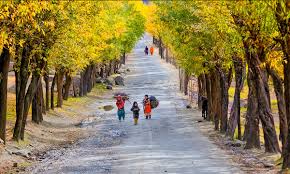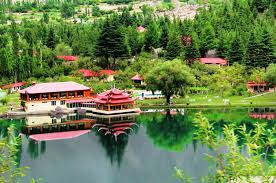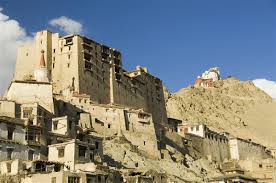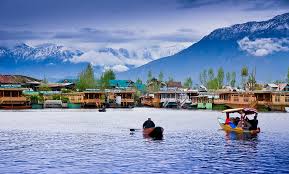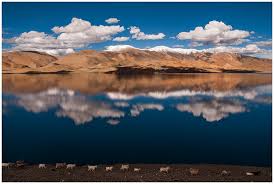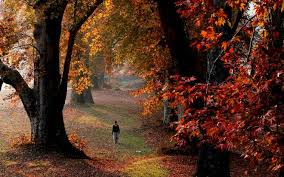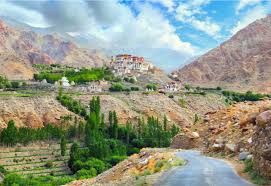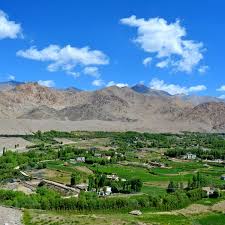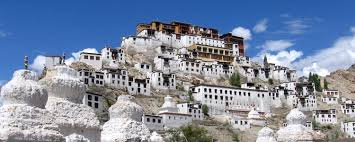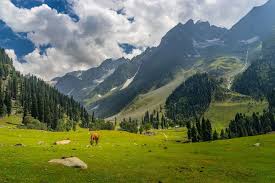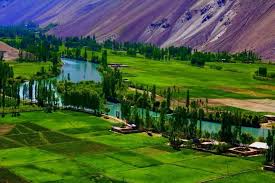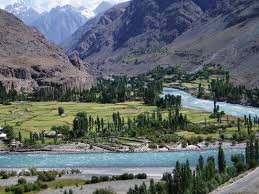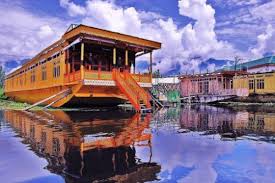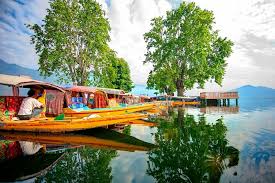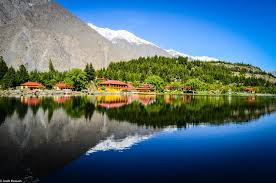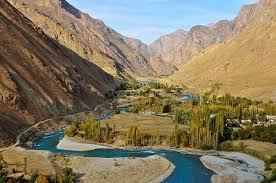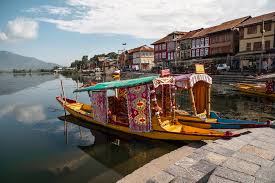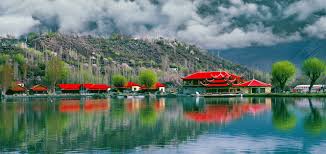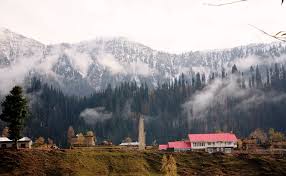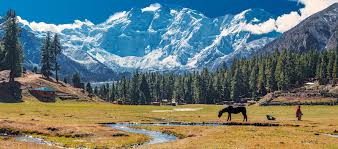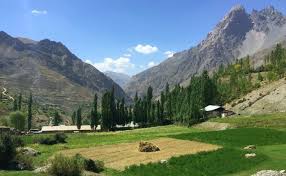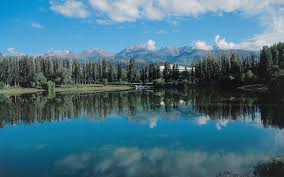
Breakfast

Transfer

Sightseeing

4/5 Star
Kashmir is India's northernmost state, sharing international borders
with Pakistan and Tibet, with Himachal Pradesh to its south. It
comprises three very different topographic and cultural regions: Jammu
region, Kashmir Valley and Ladakh-Leh. Jammu city is in the south of
the state and is the only region that lies in plains and foothills and
is the capital of the state for winter. Kashmir Valley to the north of
Jammu has higher elevations, encompassed by the Pir Panjal range on
the west and parts of the Great Himalayas on the north east. Srinagar
town, the heart of the valley is Jammu & Kashmir's summer capital.
Ladakh region is a mountain desert terrain and takes up almost 2/3rds
of J&K's territory from the centre to the east. The natural beauty
of the Kashmir valley has been a byword for centuries. The
17th-century Mughal emperors retreated here for summers and built some
famous gardens. Srinagar town is defined by the River Jhelum, the Dal
and Nagin Lakes, canals and backwaters, as well as old wooden
architecture and 17th century mosques. Nearby Gulmarg (2730m) is a
meadow with one of the highest golf courses in the world and one of
India's rare ski resorts. In contrast to the valley's comfortable
altitudes, Ladakh region is so high that it receives no monsoon rains.
The Ladakhi peaks go up to the 7135 m (Nun Peak) in the Great
Himalayas range and 7464m of the Teram Kangri 1 Peak in the Karakoram
range. The region is interspersed with oasis-villages. Ladakh has been
home to Mahayana Buddhism for a thousand years and has noted
monasteries along the River Indus: Alchi, Basgo, Thikse, Hemis and
Lamayuru. Ladakh's capital LEH,' is a good base for visiting these and
for trekking. Snowbound Ladakh is closed off by road between
October-June.
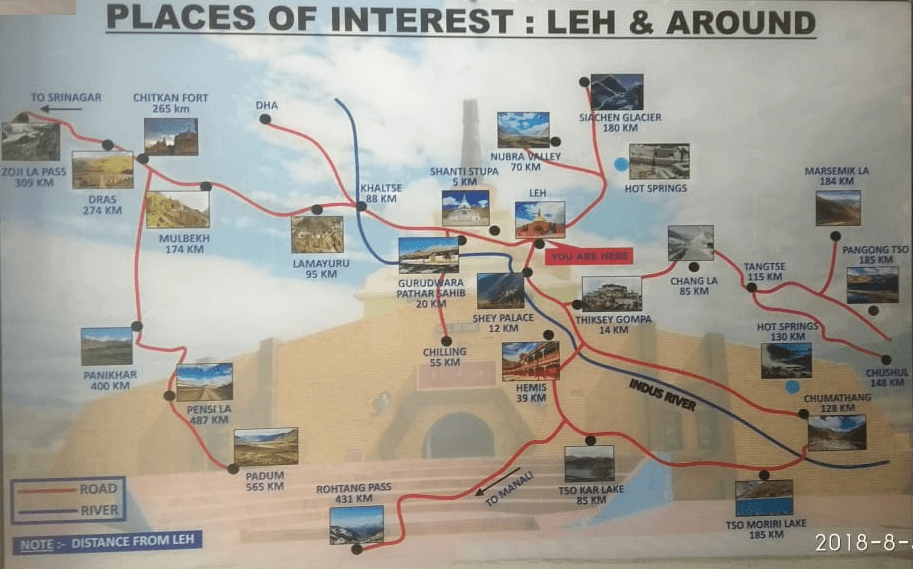

Breakfast & Dinner

Transfer

Sightseeing

4/5 Star
Khardung Pass or Khardung La is a mountain pass in the Ladakh region of the Indian state of Jammu and Kashmir and is one of the most famous landmarks of this place. It was a part of the SILK ROAD of yore. At an elevation of 18380 feet above the main sea level, Khardung La is claimed to be the “world’s highest motorable pass”.The pass is the safest gateway to Nubra valley, Shyok Valley & Siachen Glacier. If your travel itinerary includes a trip to Nubra or Shyok valley you will have to pass through the Khardung La Top.Inner line permit is required to visit Khardung La, Shyok and and Nubra valley so make sure to carry several photocopies of the permit which can be obtained from Leh. You will have to submit a copy at each check post – The South Pullu and the North Pullu. Khardung La Top is in between South & North Pullu check post.
Care is needed to visit 18380 feet high altitude pass. A number of people suffer from acute mountain sickness while at Khardung La Top. Therefore, Proper acclimatization is a must at Leh before visiting this pass.If you have taken air route and directly landed in Leh then spend minimum 3-4 days at leh or at any other nearby similar altitude place before heading towards Khardung La.
However, If you are still suffering from AMS in Leh, avoid traveling towards Khardung La and wait for the symptoms to subside. If you were OK in Leh but start to notice AMS again as you start climbing up, best to give up the idea and descend back down.
Nubra Valley Additional Tips & Information
Nubra Valley Elevation – 10,000 feet above sea level.
Distance from Leh – 150 kms.
Leh to Nubra Valley Route – Leh – Khardung La Top – Nubra Valley
Like the rest of Ladakh, Nubra is a high altitude cold desert at an elevation of 10,000 ft above sea level with little vegetation except along river beds. The ancient Silk Route passes through this valley. The bewitching beauty of Nubra Valley landscape will linger on with you for a really long time.
Diskit, Hunder, Turtuk, Sumur, Panamik, Tiger & Khalsar are some of the most popular attractions in Nubra Valley.
DISKIT
Diskit is famous for Diskit Monastery and a 32 meter tall statue of
Maitreya Buddha. A climb upto the Monastery offers panoramic view of
the landscape all around and the towering Maitrey Buddha Statue on the
opposite hill.
The imposing 32 meter tall statue of Maitreya Buddha. Visible from a
distance as soon as one enters the Diskit Region, The Maitreya Buddha
statue faces down the Shyok River towards Pakistan.
HUNDER
About 8 km away from Diskit, Hunder is renowned for it’s sand dunes
and Bactrian Camel safari
While you experience some beautiful views of the vegetation in Diskit,
Hunder is all about white desert making it another most alluring
attraction of the Nubra valley.
Camel Ride at Hunder – This wide stretch in the valley is a desert
complete with sand dunes and camels. In the afternoon gusty winds pick
up sand to create miniature sand storms over Hunder. The Bactrian
double humped camels found exclusively at this place in India, can
often be seen grazing on the dune-like landscape. One can hire a ride
on the double humped camels for Rs. 200 for an exciting experience.
The camels are taken good care by the owners and they look happy.
Camel ride timings are –
Morning : 8:00 am-10:am
Evening : 4:30pm – 6:30 pm
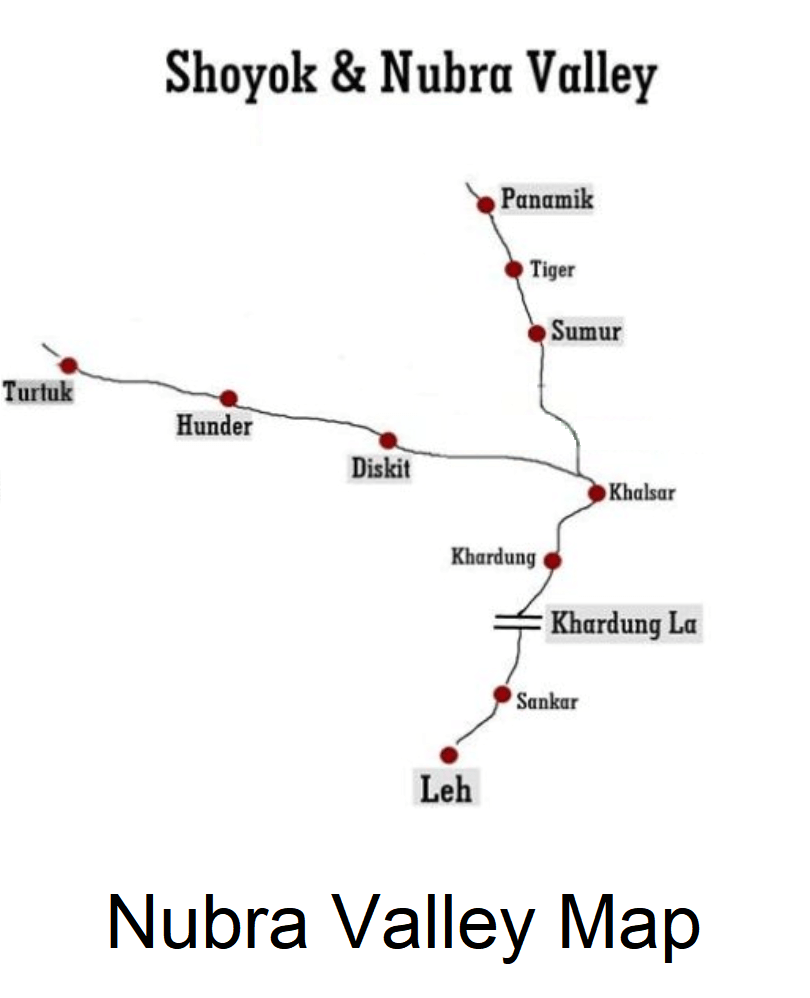

Breakfast & Dinner

Transfer

Sightseeing

4/5 Star
Lamayaru: The Moonland of Ladakh
Loacted 15 Km east of the famous Fotu La pass on the Leh-Srinagar highway, Lamayaru is popularly known as moonland by the local due to its peculiar land surface which closely resembles the surface seen on moon.
The monastery at Lamayaru is considered one of the oldest Gompas of
Ladakh and houses more than 400 Buddhist monks even today who are
undergoing training to take up responsibilities in monasteries across
the globe. Legend has it that originally the valley was a huge lake
which was dried up by the 10th century Buddhist scholar
Mahasiddhacarya Naropa to create a perfect learning center for monks.
It is also believed that the area will once again be flooded in the
future when the time ordained for it arrives as per Buddhist
scriptures. Some mythological accounts even believe that the great
sage Arhat Nyimagong cracked open the banks of the original lake using
his super natural powers and predicted that a monastery will spring
from the valley bottom to eventually become one of the most important
centers of Buddhist learning in the region.

Breakfast & Dinner

Transfer

Sightseeing

4/5 Star
85 Kms from Hunder is the the beautiful village of Turtuk on the banks
of the Shoyok river. Turtuk is the last outpost in India after which
the Pakistan-controlled Gilgit-Baltistan begins. It is the last major
village where tourist activity is allowed before the Line of Control.
Return back to your camp and rest for the day.
Covering Diskit, Hunder and Turtuk should be enough for the day.
At Sumur – Samstanling Monastry is the main attraction of this village.
At Tiger Village – Zamskhang Palace is a tourist attraction.
At Panamik Village – one can enjoy hot water springs & a few kms ahead
of Panamik one can enjoy the gorgeous views of Yarab Tso
ATV RIDE At Khalsar – On the way near village Khalsar you can enjoy
ATV ride amidst sand dunes and then make your way back towards Leh .
The thrilling ride Priced for Rs. 1200/ per ride includes a 15 minutes
drive across the sand dunes reaching upto the edge of the gurgling
Shoyok river that flows nearby. One must try this adventure activity –
the entire experience of driving on the vast stretch of sand with
panoramic view of the Mountains right in front is amazing.

Breakfast & Dinner

Transfer

Sightseeing

4/5 Star
Located in Jammu and Kashmir, Ladakh is the highest inhabited region
in India. Ladakh is known for its mystical landscape which is
characterized by snow capped mountains, frozen lakes and scenic beauty
which also serve as the major sightseeing in Ladakh. With crystal blue
water and a beautiful backdrop, Pangong Lake is one of the most
popular places to visit in Ladakh. From pashmina shawls to turquoise
jewelry to handwoven rugs and carpets, there are plenty of things that
tourists can shop for in Ladakh.
LADAKH is referred to by many names such as ‘Little Tibet’, ‘The Land
of Numerous Passes’, ‘The Broken Moon’, etc. Ladakh lies at an
altitude of 3500 metres above sea level in a cold desert. It is
nestled between the greatest mountain ranges of the world- The Great
Himalayas and the Karakoram Range.
Ladakh had been ruled by many dynasties, most of which were the
descendants of the former kings of old Tibet. Owing to its strategic
location, it also served as an eminent trade centre for India. It
connected India to Central and West Asia.
People and Culture of Ladakh
Unpredictable weather
Leh Ladakh weather is a mystery, though there are certain guidelines
that one must follow but overall it is difficult to say that you will
get only this kind of weather at a particular time of the year. You
should be prepared for everything – sun, heat, heavy rain, low
temperatures, landslides as well a snowfall and pack accordingly.
At one moment you will feel warm and the other it will be chilling
cold. The key to dressing up in Leh Ladakh is layering. Even if you
are visiting during peak summer season. Always keep your woolens or
Jackets handy even if you are going out for a walk in afternoon. Also
carry your Sunglasses and a cap all the time.
Delays & Plan cancellations
Landslides are very common in the hills and Ladakh is no exception.
Landslides may cause delays, since the passes remain closed until the
roads get cleared causing delays and plan cancellations. This is
something you will have to take into account before heading out and
keep a couple of spare days in the itinerary.
The population of Ladakh is a blend of many different ethnic
communities among which the Tibetans, Monpas and Dards are
predominant. Most of the Ladakhis are either Shia Muslims or Tibetan
Buddhists. The population also comprises a small number of Hindus,
Sikhs and followers of the Bon religion. Leh is also an eminent
Buddhist centre and home to many Tibetan refugees. Tibetan, Urdu,
Hindi, Ladakhi, Purig and English are the major languages spoken in
the region.
Things to Do in Ladakh
With crystal blue water and a beautiful backdrop, Pangong Lake is one
of the most popular places to visit in Ladakh (Leh). It lies at the
Sino-Indian Line of Actual Control, at an altitude of 4350 metres
above sea level. Among the many Ladakh (Leh) attractions, Leh Palace
is a must visit. This beautiful palace sits on top of the Namgyal Hill
and is known for its aesthetic appeal and historical significance.
Your Ladakh (Leh) tour is incomplete without visiting the Magnetic
Hill. It is the only magnetic hill in India. It has an
anti-gravitational effect due to which a car will start moving upward
on its own.
The Shanti Stupa which was established by Japanese Buddhists is also
among the popular Ladakh (Leh) places to visit. In 1983, the stupa was
opened by Dalai Lama for spreading Buddhist ideologies. Regarded as
one of the highest passes in the world, the Khardung La Pass is an
eminent Ladakh (Leh) tourist place. It is the gateway to the Nubra
Valley which boasts of a lush landscape and is brimming with wild
lavenders, roses and Alfalfa. Apart from sightseeing, there are many
other things to do in Ladakh (Leh) such as shopping and adventure
activities.
Food and Shopping in Ladakh
After a tiring day of Ladakh (Leh) sightseeing, one can savour some
mouth watering local food at the numerous restaurants and cafes. The
cuisine of Ladakh has been influenced by many foreign cuisines which
include Tibetan, Korean and Chinese. Thukpa, Tsampa and Momos are some
of the local specialties.
The markets of Ladakh have a lot to offer. From pashmina shawls to
woolen garments to turquoise jewelry to handwoven rugs and carpets,
there are plenty of things that tourists can shop for in Ladakh.
Tibetan Handicrafts such as thangka paintings, Tibetan silver jewelry,
delicate embroidery are also few of things sold at the local markets.
Bazaar Road is lined with shops that sell these items and is the best
place to go for shopping.Head over to Ladakh Art Palace to for Tibetan
handicraft items. Shar Market, Tibetan Handicraft Emporium and Tibetan
Market are some of the popular places to shop.
Accommodation in Ladakh
Since Ladakh is well connected by road and air, there are many options
for tourists who are wondering how to reach Ladakh. There are daily
flights to and from Delhi, Jammu and Srinagar. However, driving is the
best way to reach Ladakh since the routes in the region are some of
the most beautiful routes in India.
Accommodation options in Ladakh include hotels, guesthouses, lodges
and resorts. Tourists can look for hotels in Ladakh that lie in the
vicinity of the tourist places to see in Ladakh (Leh).

Breakfast & Dinner

Transfer

Sightseeing

4/5 Star
Dras is situated about 60 km away from Kargil, on the road to
Srinagar. Popularly known as ‘The Gateway to Ladakh’, Dras is the
coldest inhabited place in India and the second coldest inhabited
place in the world (Siberia being the first).
The first village after Zoji La pass, Dras is situated at a height of
10,990 feet above sea level. In the freezing winter, temperatures in
Dras can drop to as low as -45 degrees Celsius. The lowest temperature
drop observed in Dras was during the winter of 1995, when the thermal
reading fell to -60 degrees Celsius !
Intensely beautiful, challenging and numbingly cold, this Himalayan
getaway is like none other.
In summer, the gorgeous valley is resplendent with wildflowers
blooming in colourful abandon.
The Srinagar-Leh road drive, which skirts the Dras river, is
staggeringly beautiful. The lofty landscape of Ladakh unfolds itself
as the dense green forest-clad slopes give way to desolate multi-hued
mountains.
The tiny villages nestled between towering mountains are surrounded by
terrace farms cut out along hillsides,These terraces are home to
groves of poplar and willow, orchards of apples and apricots and
fields of barley and buckwheat..
This is a land where time stands still. The snow sculpted landscape of
Dras valley will touch you and move you in ways only nature can.,If
Ladakh is paradise, Dras is your stairway to heaven..
The natives of Dras, belonging to the Dard and Balti community, are
hardy people. They speak the Shina language and make their homes in
small clusters of huts scattered all over the Dras valley..
During the summer months, the nomadic mountain tribes of Gujjars and
Bakkerwaals make an almost ritualistic journey to the Dras valley
through the formidable Zoji la in search of precious grazing grounds
for their livestock. They set up their camps in the meadows in the
highest parts of the valley. Clad in beautifully embroidered garments,
the nomads are often escorted by ferocious gaddi dogs..
In winter, everything in Dras valley freezes – the rivers, the lakes,
the mountains..
Dras is known to host riveting contests of polo, the favourite sport
of the landlocked region. Horsemanship is a treasured tradition of the
Dard natives and polo is played with particular zeal and fervour in
Dras.
SIACHEN
(Click on title to view images)

Breakfast & Dinner

Transfer

Sightseeing

4/5 Star

Breakfast & Dinner

Transfer

Sightseeing

4/5 Star

